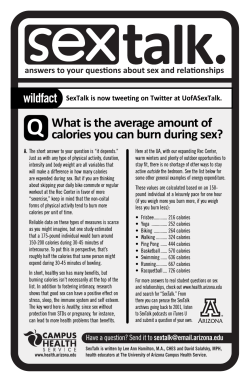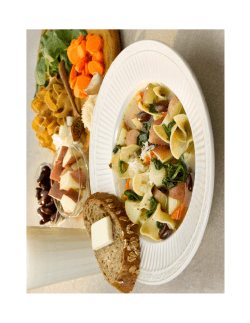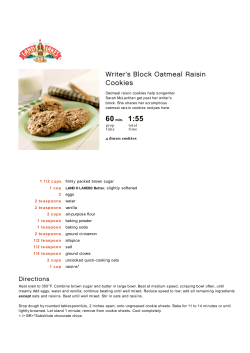
Trail Mix Math Precepts Time Resources
Lesson Number: MS.FS.4.5 Trail Mix Math Middle School Food and Agricultural Literacy Curriculum Precepts B. Relationships B2. Interact and work with others. National Standards FPP.03.01.03.b. – Compare and contrast the nutritive value of food and food groups. FPP.03.01.04.a. Discuss common food constituents (e.g., proteins, carbohydrates, fats, vitamins, minerals). NL-ENG.K-12.12 – Applying Language Skills NS.5-8.6 – Science in Personal and Social Perspectives NT.K-12.5 – Technology Research Tools Student Learning Objectives As a result of this unit the student will… Critique food labels and claims As a result of this lesson, the student will … Evaluate and research nutritional content of food products. Content Outline Objective 1. Apply math concepts related to interpreting and calculating information on food labels. Time Instruction time for this lesson: 45 minutes. Resources Taste of Home. (2010). Trail mix recipe. Retrieved February 5, 2010, from Taste of Home: Cooking, Caring, Sharing. Web site: http://www.tasteofhome.com/Recipes/Trail-Mix Livestrong.com. (2010). How to calculate calories in a recipe. Retrieved February 5, 2010, from Livestrong.com: Dare to Change Your Life. Web site: http://www.livestrong. com/article/38311-calculate-calories-recipe/ Agricultural Research Service. (2009). USDA National Nutrient Database for standard reference. Retrieved February 5, 2010, from United States Department of Agriculture: Agricultural Research Service. Web site: http://www.nal. usda.gov/fnic/foodcomp/search/ Tools, Equipment, and Supplies Overhead projector/transparencies Dry roasted peanuts (non-salted or salted) – 2 pounds Cashews (salted or non-salted) – 2 pounds Raisins – 2 pounds M&M candies (peanut or plain) – 2 pounds Flaked coconut – ½ pound Packaged Trail Mix – 1 bag/package for Interest Approach Large mixing bowl Large mixing spoon Styrofoam coffee cups – 1 per student Computer and LCD projector with Internet access (If not available, search the food data for each ingredient and create copies for each student.) Calculators – one per student MS.FS.4.5.AS.A– one per student MS.FS.4.5.TM.A– one per student or display using LCD projector MS.FS.4.5.ASSESS.A – one per student Key Terms The following terms are presented in this lesson and appear in bold italics: Serving Size I. Calculation of calories in a recipe can be accomplished in six simple steps: A. First, separate the packaged foods from the non-packaged foods in the recipe. B. Second, record the number of calories in each serving of the packaged foods according to the food’s label. If the food uses multiple servings record the total calories. (i.e. – Granulated Sugar contains 774 calories per cup. If a recipe calls for 2 cups of sugar, record 1,548 calories.) C. Third, determine the number of calories in the non-packaged foods. This can be found online Food Science: Food Nutrition and Labeling Calories Calories Per Serving at United States Department of Agriculture’s National Nutrient Database (http://www.nal. usda.gov/fnic/foodcomp/search/). 1. Type in the desired food name and select “search.” 2. Select the specific desired food from the search results and select “submit.” 3. Select the desired measure, (grams, cups, or ounces), and select “submit.” 1 Lesson Number: MS.FS.4.5 Middle School Food and Agricultural Literacy Curriculum Trail Mix Math 4. Reference the desired nutritional information (Calories are referenced as “Energy” in “kcal” units). 5. Repeat for each non-packaged food. D. Fourth, Add the total number of calories for both packaged and non-packaged foods. E. Fifth, identify the total number of servings in the recipe. F. Sixth, divide the total number of calories in the recipe by the total number of servings in order to determine the calories per serving. Interest Approach Before today’s lesson become very aware of any food allergies students in your classes may have. Contact both administration and parents concerning the consumption of food products if school policy mandates it. Finally, if food consumption is not allowed in classrooms at your school, the lesson may still be conducted without the creation of the trail mix. Hello class! Today we are going to calculate calories in a food recipe while creating our own food product! Eyes and ears should be alert today. If we miss a step we may not be able to eat our products at the end of class. Holding up a bag of real trail mix, or just the wrapper. Think about how many calories are in this bag. The serving size is ____. How many calories are there per serving? Turn to a neighbor and share a hypothesis. Wait for students to share. What is the average of your answer and your neighbor’s answer? Who will be the first to share their average with the class? Wait for student answers. Great estimations and calculations! The exact answer is ____. Today it will be our objective to learn more about the calculation of calories in a food, while creating a healthy snack! Food Science: Food Nutrition and Labeling Summary of Content and Teaching Strategies Objective 1. Apply math concepts related to interpreting and calculating information on food labels. The lesson will ask students to calculate the caloric value of foods in the trail mix recipe. Pour all foods out of their original containers, with the exception of the M&M candies so their caloric value can be calculated by weight rather than their packaging. After adding each ingredient into the mixing bowl, search the appropriate ingredient on the USDA’s National Nutrient Database (http://www.nal.usda. gov/fnic/foodcomp/search/). Allow students to record data from the nutritional information for each ingredient on MS.FS.4.5.AS.A. Before we can begin down the trail of calorie calculation, we must lay some groundwork. Please pause and hear these directions. When you receive this activity sheet (MS.FS.4.5.AS.A), place your name at the top and allow it to rest on your desk. Next, the class will observe as ingredients are added to this large bowl, one at a time. After each ingredient is added, we will search a website to discover data concerning the caloric content of the ingredient. Record this content and complete any needed calculations on the activity sheet. This will be done in a step-by-step fashion and only individuals with complete sheets receive trail mix at the end of the lesson! Who will summarize what we are about to do? Thank you! Okay, here are the sheets! Distribute MS.FS.4.5.AS.A and make any needed clarifications. In calculating calories for a recipe, the first step is to separate recipe items into two categories, packaged and non-packaged food items. How would we categorize our recipe items today? All items should be poured into container so student can see them. Correct, all of our items today are non-packaged food items, except for the M&M’s. Let’s move to step two! 2 Lesson Number: MS.FS.4.5 Middle School Food and Agricultural Literacy Curriculum Trail Mix Math Next, we will have a look at the packaged food item’s label. The M&M’s label is here on the bag. Hold the bag up and show the nutrition facts. Here are the servings and calories per serving for the M&M’s. Read from the M&M’s nutrition facts. Give students the number of servings in the package and the calories per serving. Okay, let’s pour these into the bowl and calculate our calories. Today we are using two pounds of M&M’s, so how many total servings is this? Allow students to make calculations on their activity sheets and answer. Excellent, there are servings in these two pounds of M&M’s. Now, how many calories are there in all of these servings? How do we calculate that? Correct, we will choose ounces, because we are measuring our ingredients in pounds today. Oh my, look at all of the data! We are only interested in calories, so let’s put the knowledge to work we gained from last time. Calories are a measure of what? Energy! Correct, so let’s go ahead and choose the unit labeled kcal, which stands for kilocalorie and is our standard caloric unit of measurement. Record that number in the appropriate place on the activity sheet. But wait, how do we determine the total calories if that is just for one ounce? Well, who will share the total weight of peanuts we are using today? Twopounds, great! Now, how many ounces are there in a pound? This is a sharp crew! There are 16 ounces in a pound. Now put it all together. Calculate the number of calories in two pounds of peanuts and record the information on the activity sheet. Repeat the same process for the cashews, raisins, and flaked coconut. Have students direct you through the process or even invite a student to the computer to lead the process. After adding all ingredients mix the ingredients thoroughly. Prompt students to answer. Correct, we simply multiply the number of servings by the number of calories per serving. Everyone do the math and record answers on the activity sheet. Let’s move on to Step #3. The third step challenges us to calculate the calories from the non-packaged foods. To do this, we will need the government’s help! Specifically, the United States Department of Agriculture! Have the website cued and the projector ready The site we see here allows us to search any food and determine its specific nutritive values. Let’s give it a whirl! First, type in the food name and click “Search.” We will do dry roasted peanuts first. Wow, we now have a choice to make, salted or nonsalted. Today we are using peanuts, so let’s choose the appropriate one and click “Submit.” Now we have three more choices dealing with units of measure. Think for a moment about how we are measuring our ingredients today. Who will tell us which one to choose? Food Science: Food Nutrition and Labeling Excellent work, everyone; now let’s move to the next step. The fourth step is very simple. It requires us to add the total number of calories from the packaged and non-packaged foods. Let’s make that happen on our activity sheets. Please seek clarification from a neighbor or myself if you need assistance. It looks as if everyone is wrapping up so let’s move to the next step. The fifth step requires that we determine how many servings are in this mix. Well, I did some research and this volume of trail mix contains approximately 48 servings, so let’s record that on our activity sheets. Okay, it is time for the final step. Who will speculate as to what the final mathematical process will be today in order to determine the calories per serving? Yes, very wise you are! We simply divide total number of calories by the total number of servings. Make that calculation happen! 3 Lesson Number: MS.FS.4.5 Middle School Food and Agricultural Literacy Curriculum Trail Mix Math Super work! Now, when I say COME AND GET IT, form an orderly line at the table and collect a Styrofoam cup. I will serve each of you one serving of trail mix. Then please return to your seat and await further directions for our next activity while enjoying our trail mix. COME AND GET IT! Review/Summary Use the Go-With-The-Flow e-Moment® for students to create a flowchart of the steps they went through to calculate the caloric content of their trail mix. Have a supply of paper and markers ready to distribute. Also, copy or project MS.FS.4.5.TM.A as a sample. Thank you class for a wonderful day! Knowing how to calculate the caloric contents of the food we prepare and eat allows us to better make healthy choices. Keep your eye on nutrition labels as tomorrow we will be even further in-depth. Application Extended classroom Activity: Have students select their favorite recipe from home. They will then create a nutrition label for that meal or dessert. FFA Activity: Great job on the calculations, class, and thank you for attentively waiting for our next activity! Take a second to review everything we had to do to calculate the caloric content of trail mix. Pause for student reflection. When I say GO WITH THE FLOW, create a flowchart on a blank piece of paper that takes us through all six steps of the process. Flowcharts utilize special shapes to indicate meaning. Here is sample flowchart and the meanings of common symbols. Use markers if you wish. Two minutes will be offered to complete this task. What questions are there? GO WITH THE FLOW. Monitor student work and count down time to keep students on task. Today, we relied on one another for information and assistance. We took things one step at a time, everyone relied on me or someone else to provide information, we checked one another’s work. Did this make the task easier or more difficult? Pause for students to share. Create a school spirit trail mix for the upcoming game/ school activity. Create cheap tags and nutrition labels. Sell the items during the game as a fundraiser. SAE Activity: Research all careers in agriculture that require balancing a ration. This can include the animal nutrition industry. Evaluation MS.FS.4.5.ASSESS.A Answers to Evaluation 1. False 2. True 3. True 4. False 5. False With that same partner, discuss what we could have done better to work as a group next time. Pause for students to share. Who will be first to share what they have came up with as a solution? Pause for students to share. In the agriculture industry and in this class, we work with people every day. Being aware of our actions and how they contribute to a team effort will serve everyone on a team. Food Science: Food Nutrition and Labeling 4 MS.FS.4.5.AS.A Calculating Caloric Content of a Recipe Name: __________________________________________ Step 1: Packaged Foods Non-Packaged Foods Step 2: Ingredient Quantity Calories/ Serving No. of Servings Total Calories M&M Candies Step 3: Ingredient Quantity kcal/ounce Ounces/Pound Total Calories Dry Roasted Peanuts Cashews Raisins Flaked Coconut Step 4: Packaged Food Calories Non-Packaged Food Calories Total Calories Step 5: Total Number of Servings Step 6: Total Number of Servings Food Science: Food Nutrition and Labeling Total Calories Calories Per Serving 5 MS.FS.4.5.TM.A Flowchart Shapes & Sample Flowchart Start Do Something Address Envelope Fold Letter Decision Place in Envelope Connector Yes Have Stamp? Start or Stop NO Borrow stamp Input or Output Place stamp on envelope Direction of Flow Stop Source: http://homepage.cs.uri.edu/book/programming/programming.htm Food Science: Food Nutrition and Labeling 6 MS.FS.4.5.ASSESS.A Calculating Caloric Value Assessment Name: __________________________________________ True/False Directions: Place an “A” in the blank next to the question for True and a “B” for False. ______1. kJ or kilojoules is the standard measurement for food energy or calories. ______2. Packaged foods have pre-calculated calories per serving on their nutrition facts label. ______3. Non-Packaged foods can be measured in grams, ounces, or cups. ______4. The Food & Drug Administration provides the National Nutrient Database. ______5. Total calories in a recipe are determined by the sum of packaged and non-packaged foods’ caloric values. Food Science: Food Nutrition and Labeling 7
© Copyright 2025


















